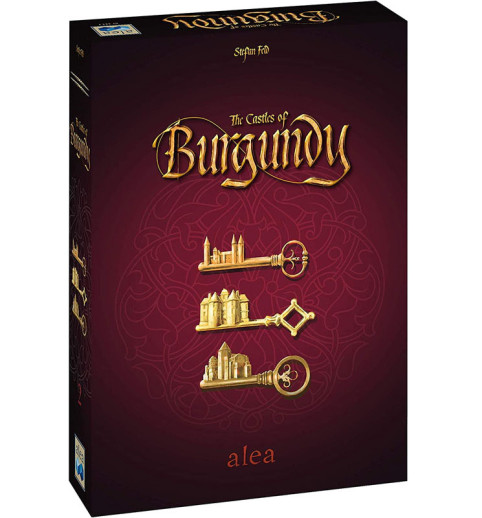We use cookies to make your experience better. To comply with the new e-Privacy directive, we need to ask for your consent to set the cookies. Learn more.
Castles of Burgundy Game
As a Duke in 15th Century Burgundy, France, bring your settlement to life! With 16 different player mats, there is great variation and many different ways to score victory points while using planning skills and strategy to build your estate. Some actions taken will be building your city, farming, trading along the river, mining for silver and speaking with travelers to gain useful information to help in your endeavors. There are five “phases" to the game consisting of five rounds each. The object of the game is to use a player board to build a city consisting of six types of six-sided tiles which players have an opportunity to draw from the main board. The tiles are color-coded by construction type, and when played, they award players either immediate victory points, special actions, end-round or end-game items or points. There are also castle tiles which give players an additional turn action, animal tiles that furnish immediate victory points and eight unique building tiles that each offer specific rewards or actions. There are also ship cards which advance a player's turn order and gives them goods tiles which can be sold as well as science cards with unique benefits during or after the game. Finally, mine tiles can be placed that award coins at the end of each phase. During each round, players roll their two dice which will determine the choices of building tiles that they can obtain. When placing these building tiles on their player boards, there are specific colored and numbered groups of building slots, which correlate to their dice rolls. Some actions do not need a specific die count, such as selling goods for money (silverlings) or purchasing worker tiles. Worker tiles allow players to add or subtract from their dice counts during any turn. Finally, one action is available each turn in addition to the actions that require use of one of a player's dice. On the main board, is a central area, which contains tiles available at a cost of two silverlings each that any player can purchase. Players earn victory points during the game for being the first to complete building sections on their board, being the first to complete specific building types and also if they completely cover their city with buildings. The game ends after five rounds of play at which time any additional victory points are added to each player's score. Players receive additional points from unused resources as well as science cards that provide game-end points. The player with the most victory points wins! This game is fun, easy to learn and it has been a highly rated favorite for many years. For two to four players, with a 30 to 90-minute game time based on player count.
As an influential prince in 15th century France, you do everything in your power to make your lands flourish. From academic progress and city development, to agriculture and trading, many roads to prosperity are open to you. Choose your path wisely, make your decisions carefully, and lead your realm to fortune and prestige!
| Product Format: | Other |
|---|---|
| Brand: | Ravensburger |
| Grades: | 7-AD |
| EAN/UPC: | 4005556269259 |
| Length in Inches: | 12.25 |
| Width in Inches: | 8.75 |
| Height in Inches: | 2.75 |
| Weight in Pounds: | 4.3 |

